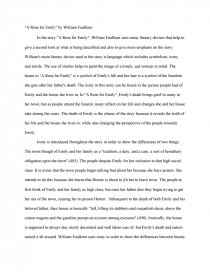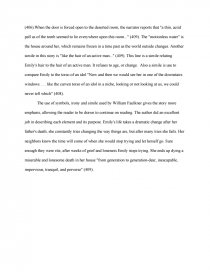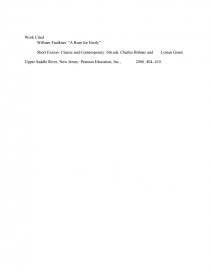A Rose for Emily by William Faulkner
Essay by Kill009 • November 16, 2011 • Essay • 1,041 Words (5 Pages) • 2,536 Views
"A Rose for Emily" by William Faulkner
In the story "A Rose for Emily", William Faulkner uses many literary devises that help to give a second look at what is being described and also to give more emphasis on the story. William's main literary device used in the story is language which includes symbolism, irony, and simile. The use of similes helps to paint the image of a lonely, sad woman in mind. The house in "A Rose for Emily" is a symbol of Emily's life and her hair is a symbol of the freedom she gets after her father's death. The irony in this story can be found in the picture people had of Emily and the house she lives in. In "A Rose for Emily", Emily's death brings grief to many in her town, but as people attend the funeral, many reflect on her life and changes she and her house take during the years. The death of Emily is the climax of the story because it reveals the truth of her life and the house she lives in; while also changing the perspective of the people towards Emily.
Irony is introduced throughout the story in order to show the differences of two things. The town though of Emily and her family as a "tradition, a duty, and a care; a sort of hereditary obligation upon the town" (405). The people despise Emily for her inclusion in that high social class. It is ironic that the town people begin talking bad about her because she buys poison. She intends to do this because she learns that Homer is about to jilt her to leave town. The people at first think of Emily and her family as high class, but once her father dies they begin trying to get her out of the town, causing her to poison Homer. Subsequent to the death of both Emily and her beloved father, their house is basically "left, lifting its stubborn and coquettish decay above the cotton wagons and the gasoline pumps-an eyesore among eyesores" (408). Ironically, the house is supposed to always stay nicely decorated and well taken care of, but Emily's death and nature turned it all around. William Faulkner uses irony in order to show the differences between beauty and unattractiveness.
Symbolism in the story closely relates to Emily which is the house and her hair. Emily's house is a Symbol of her physical and emotional decay. Many people saw Emily's death and her house as a "fallen monument" (406). After the death of Emily's father, the house and Emily begin to go downhill. Her health and the house begin decaying to the point where she stops taking care of herself. At her father's funeral "she looked bloated, like a body long submerged in motionless water and of that pallid hue" (408). Emily's health slowly begins to decay leading up to her death, which leaves the house "lifting its stubborn and coquettish decay above the cotton wagons and the gasoline pumps-an eyesore among eyesores" (409). In the beginning Emily and her house are seen as monuments, as time passes both the house and Emily slowly perish. The author carries
...
...



